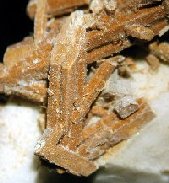Thumbnails

Bastnäsite-(Ce) crystals
Photo by Bill Lechner
© Bill Lechner
Ce(CO)F
Bastnäsite-(Ce) is a rare accessory mineral occurring in several environments at MSH. It is a late stage mineral in the paragenesis sequence. It is one of the most common REE mineral species at Mont Saint-Hilaire.
PHYSICAL CHARACTERISTICS:
Color varies from white, beige, pale pink, pale gray or greenish
gray on flakes; and gray to tan for pseudomorphs.
Luster is dull pearly for the flakes and dull for pseudomorphs.
Diaphaneity: flakes are opaque, others translucent to opaque.
Crystal System is hexagonal; 62
Crystal Habits include minute hexagonal or rounded flakes,
very small spheres and rosettes, crude prismatic pseudomorph
to 5cm.
Cleavage {001} is distinct to perfect and {010} is indistinct.
Fracture is uneven.
Hardness is 4 – 4.5
Specific Gravity is approximately 5.0 g/cm
Streak is white.
Associated Minerals include aegirine, albite, amphibole group,
analcime, ancylite, apophyllite series, ashcroftine, astrophyllite,
barite, brookite, calcite, catapleiite, cordylite, donnayite, elpidite,
epididymite, fluorapatite, fluorite, galena, leucophanite, lorenzenite,
natrolite, pyrochlore, pyrophanite, quartz, rhodochrosite, rutile,
sérandite, siderite and zircon.
Distinguishing Features: Crystal habit and luster.
Origin: Named in 1841 after its discovery locality, at Bastnäs,
Ridarhyttan district, Västmanland, Sweden.
CLASSIFICATION:
Dana System
# 16a.1.1.1
Strunz Classification
# V/C.7-30
REFERENCES:
MinRec 21:298 (1990), Dana 8:476-477 (1997)
DISTRIBUTION AND RARITY AT MONT SAINT-HILAIRE:
MSH
¤¤¤
